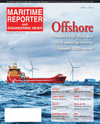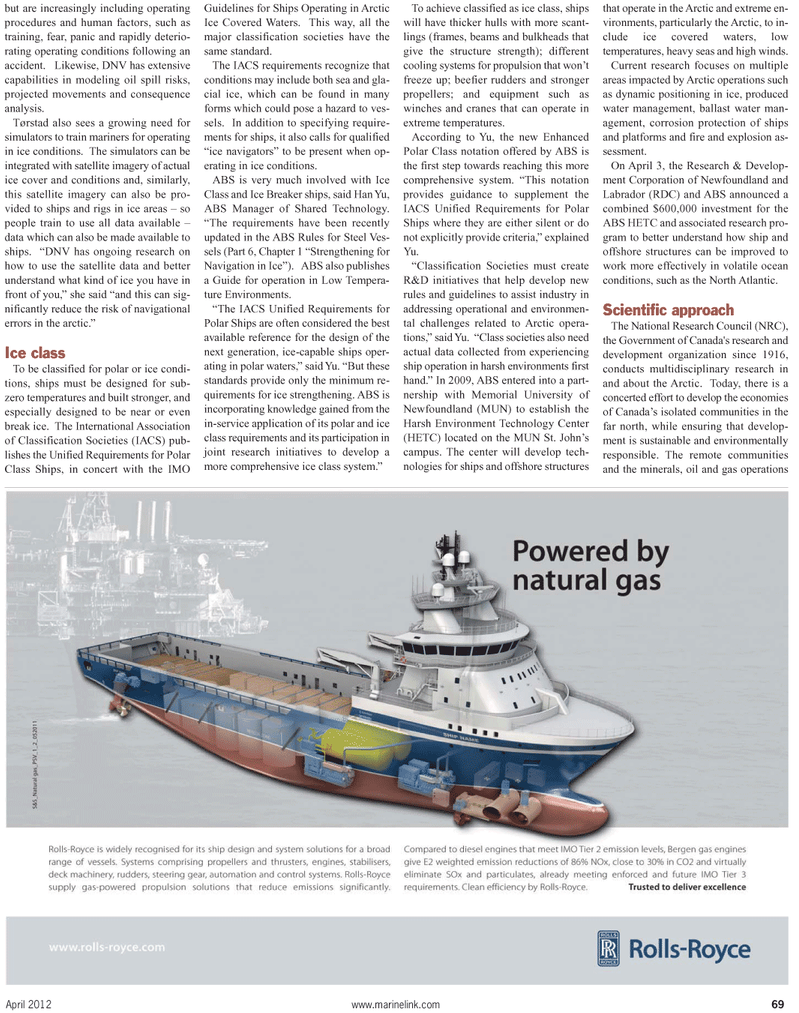
Page 73: of Maritime Reporter Magazine (April 2012)
Offshore Deepwater Annual
Read this page in Pdf, Flash or Html5 edition of April 2012 Maritime Reporter Magazine
April 2012www.marinelink.com 69but are increasingly including operating procedures and human factors, such as training, fear, panic and rapidly deterio- rating operating conditions following an accident. Likewise, DNV has extensive capabilities in modeling oil spill risks,projected movements and consequence analysis. Tørstad also sees a growing need for simulators to train mariners for operatingin ice conditions. The simulators can be integrated with satellite imagery of actual ice cover and conditions and, similarly, this satellite imagery can also be pro-vided to ships and rigs in ice areas ? sopeople train to use all data available ? data which can also be made available to ships. DNV has ongoing research on how to use the satellite data and better understand what kind of ice you have in front of you,? she said and this can sig- nificantly reduce the risk of navigational errors in the arctic.? Ice classTo be classified for polar or ice condi- tions, ships must be designed for sub-zero temperatures and built stronger, and especially designed to be near or even break ice. The International Association of Classification Societies (IACS) pub- lishes the Unified Requirements for Polar Class Ships, in concert with the IMOGuidelines for Ships Operating in Arctic Ice Covered Waters. This way, all the major classification societies have the same standard.The IACS requirements recognize that conditions may include both sea and gla-cial ice, which can be found in many forms which could pose a hazard to ves- sels. In addition to specifying require- ments for ships, it also calls for qualified ice navigators? to be present when op- erating in ice conditions.ABS is very much involved with Ice Class and Ice Breaker ships, said Han Yu, ABS Manager of Shared Technology. The requirements have been recently updated in the ABS Rules for Steel Ves- sels (Part 6, Chapter 1 Strengthening for Navigation in Ice?). ABS also publishes a Guide for operation in Low Tempera- ture Environments. The IACS Unified Requirements for Polar Ships are often considered the bestavailable reference for the design of the next generation, ice-capable ships oper- ating in polar waters,? said Yu. But these standards provide only the minimum re- quirements for ice strengthening. ABS is incorporating knowledge gained from the in-service application of its polar and iceclass requirements and its participation injoint research initiatives to develop a more comprehensive ice class system.? To achieve classified as ice class, ships will have thicker hulls with more scant- lings (frames, beams and bulkheads that give the structure strength); different cooling systems for propulsion that wont freeze up; beefier rudders and stronger propellers; and equipment such aswinches and cranes that can operate inextreme temperatures. According to Yu, the new Enhanced Polar Class notation offered by ABS is the first step towards reaching this more comprehensive system. This notation provides guidance to supplement the IACS Unified Requirements for Polar Ships where they are either silent or do not explicitly provide criteria,? explained Yu. Classification Societies must create R&D initiatives that help develop new rules and guidelines to assist industry inaddressing operational and environmen- tal challenges related to Arctic opera- tions,? said Yu. Class societies also need actual data collected from experiencing ship operation in harsh environments first hand.? In 2009, ABS entered into a part- nership with Memorial University of Newfoundland (MUN) to establish the Harsh Environment Technology Center (HETC) located on the MUN St. Johns campus. The center will develop tech- nologies for ships and offshore structures that operate in the Arctic and extreme en- vironments, particularly the Arctic, to in- clude ice covered waters, low temperatures, heavy seas and high winds. Current research focuses on multipleareas impacted by Arctic operations such as dynamic positioning in ice, producedwater management, ballast water man- agement, corrosion protection of shipsand platforms and fire and explosion as- sessment.On April 3, the Research & Develop- ment Corporation of Newfoundland and Labrador (RDC) and ABS announced a combined $600,000 investment for the ABS HETC and associated research pro-gram to better understand how ship and offshore structures can be improved to work more effectively in volatile ocean conditions, such as the North Atlantic. Scientific approach The National Research Council (NRC),the Government of Canada's research and development organization since 1916, conducts multidisciplinary research inand about the Arctic. Today, there is a concerted effort to develop the economies of Canadas isolated communities in the far north, while ensuring that develop- ment is sustainable and environmentally responsible. The remote communities and the minerals, oil and gas operations

 72
72

 74
74
